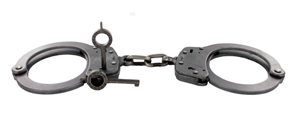Handcuff Finishes
Nickel: Nickel plating is the most popular handcuff finish. Our two best sellers, the Smith & Wesson Model 100 and the Peerless Model 700 both are nickel plated handcuffs. Smith & Wesson does a satin nickel finish on their handcuffs giving them a rougher appearance that is less reflective, and easier to grip. Peerless’ nickel finish is much more shiny and smooth. CTS, Hiatt, ASP and Chicago also nickel plate a majority of their restraints.

Blued: Bluing (black oxide), not the actual color blue, but the same process used to protect firearms and make them black. Blued handcuffs are very popular. Bluing is used to add mild corrosion resistance to handcuffs. Black oxide finishes require regular lubrication to remain rust-free. Smith & Wesson, Peerless and Hiatt all have blued (black) handcuffs in their lineups.

Melonite: Melonite is trademarked salt bath nitriding process used to blacken handcuffs and increase surface hardness. S&W uses the same process on their guns. Glock uses a very similar process called Tenifer They have two models of Melonite handcuffs: their standard model 100 in a Melonite finish and their M&P Melonite handcuff with finger activated double locks.

Stainless: There aren’t many stainless steel handcuffs on the market today. Stainless steel is used in a variety of applications because it is extremely resistant to rust.

Colored Handcuffs
Color Plated: Peerless Handcuffs are available in 5 different colors. The color coating is applied using a process called Electrolytic Polyurethane Plating (EPP). EEP fully coats restraints inside and out without interfering with the lock mechanism and jaw swing through.

Powder Coated: CTS (formerly Hiatt-Thompson) colored handcuffs are powder coated. As part of their process, the end of the swinging arms of CTS handcuffs is not fully coated.

Weathershield: Smith & Wesson calls their colored handcuffs Weathershield handcuffs. Smith & Wesson coats the whole handcuff except the chain and swinging arm in a durable colored finish.
